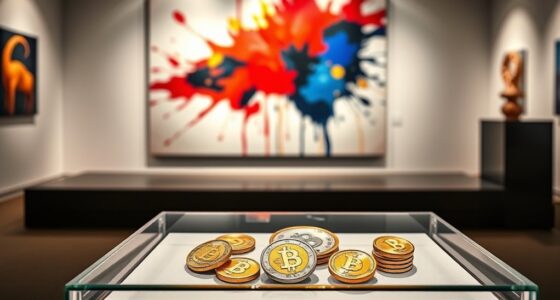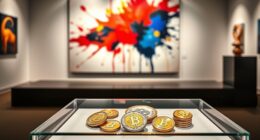Blockchain and NFTs transform provenance and sales by offering secure, transparent records that verify an asset’s authenticity and ownership. Digital signatures ensure the genuineness of information, while smart contracts automate transactions and enforce sale terms. The blockchain’s immutable ledger provides an unalterable history, making high-value items like art and collectibles more trustworthy. As you explore further, you’ll discover how these technologies are shaping a more secure and efficient marketplace for valuable assets.
Key Takeaways
- Blockchain provides an immutable ledger for recording transparent, tamper-proof provenance histories of NFTs and high-value assets.
- Digital signatures authenticate asset information, ensuring the origin and ownership records are trustworthy.
- Smart contracts automate sale terms, including payment verification and instant transfer of digital assets like NFTs.
- Provenance verification through blockchain reduces counterfeiting, enhances buyer confidence, and supports genuine asset transactions.
- Combining digital signatures, smart contracts, and blockchain enhances security, streamlines processes, and expands digital asset markets.

Have you ever wondered how blockchain and NFTs are transforming the way we verify the origin and sell valuable items? At the core of this revolution are digital signatures and smart contracts, which work together to create a secure, transparent system for provenance and transactions. Digital signatures serve as digital fingerprints, ensuring that every piece of information related to an asset is authentic and tamper-proof. When a seller or owner signs a digital document with their private key, it confirms their identity and the integrity of the data. This process makes it nearly impossible for anyone to forge or alter records without detection, giving buyers confidence in the authenticity of the item’s history.
Digital signatures verify asset authenticity, ensuring tamper-proof records and buyer confidence in digital transactions.
Smart contracts take this security a step further by automating the terms of a sale or transfer. These self-executing contracts are programmed with specific conditions—such as the transfer of ownership upon payment—and run automatically when those conditions are met. For example, when you buy an NFT representing a digital artwork, a smart contract can verify that the payment has been received and then transfer the ownership rights to your digital wallet instantly. This eliminates the need for intermediaries, reduces delays, and cuts costs associated with traditional transactions. Plus, because smart contracts are stored on the blockchain, they’re transparent and accessible to all parties involved, reducing disputes and increasing trust.
The combination of digital signatures and smart contracts makes blockchain-based provenance highly reliable. Every transaction is recorded on an immutable ledger, providing a clear, unalterable history of an asset’s origin and ownership changes. This transparency is especially valuable for high-value collectibles, art, and luxury items, where authenticity and history are critical. When you view an item’s blockchain record, you can trace its journey from creation to sale with confidence. This process not only deters counterfeiters but also reassures buyers that they’re investing in genuine, verified assets.
In addition, understanding the importance of emotional support can help buyers and sellers navigate the emotional aspects of high-value transactions, ensuring confidence and peace of mind throughout the process.
In essence, these technologies empower you to verify authenticity and execute sales with a level of security and efficiency that traditional methods can’t match. Digital signatures ensure that each record is genuine, while smart contracts automate and enforce the terms of a sale, making transactions smoother and more trustworthy. As blockchain and NFTs continue to evolve, their role in provenance and sales will only grow, offering you a more transparent, secure way to buy, sell, and verify valuable items in the digital age.
Frequently Asked Questions
How Secure Are Blockchain Transactions Against Hacking?
Blockchain transactions are generally very secure because they use strong cybersecurity measures and transaction encryption. You benefit from decentralized networks, making it hard for hackers to target a single point of failure. However, no system is entirely foolproof. You should still stay vigilant, keep your private keys safe, and use reputable platforms to reduce risks, ensuring your transactions remain protected against hacking attempts.
Can NFTS Be Duplicated or Forged Easily?
NFTs can’t be easily duplicated or forged because they use digital watermarking and blockchain technology for counterfeit detection. When you own an NFT, its unique digital signature is securely recorded on the blockchain, making forgery nearly impossible. This combination helps you verify authenticity and protect your digital assets, ensuring your NFT remains one-of-a-kind and resistant to duplication or counterfeit attempts.
What Are the Environmental Impacts of Blockchain Technology?
You might be concerned about the environmental footprint of blockchain technology, especially regarding energy consumption. Blockchain networks, particularly proof-of-work systems, use significant energy, which can impact the environment negatively. However, many projects are now shifting to more sustainable methods like proof-of-stake, reducing energy use. By choosing eco-friendly blockchains, you can help lower the environmental footprint and support greener technology solutions.
How Does Blockchain Handle Ownership Disputes?
When you face an ownership dispute, blockchain helps by providing clear ownership verification through a transparent, tamper-proof ledger. Dispute resolution is often handled via smart contracts or consensus mechanisms, which automatically enforce rules and validate claims. You can track the entire transaction history, making it easier to resolve disagreements quickly and confidently. This system minimizes fraud and guarantees that ownership records remain accurate and trustworthy.
Are There Legal Regulations for NFT Sales Worldwide?
You should know that legal regulations for NFT sales vary widely worldwide, creating significant jurisdictional challenges. Some countries implement strict legal compliance measures, while others lack specific regulations altogether. This disparity means you must navigate different legal landscapes, understanding local laws on digital assets, intellectual property, and consumer protection. Staying informed about evolving regulations helps you avoid legal pitfalls and guarantees your NFT transactions remain compliant across various jurisdictions.
Conclusion
You now hold the key to a new era, where blockchain and NFTs weave a transparent tapestry of provenance and sales. Like a steady lighthouse guiding ships through foggy waters, these technologies illuminate authenticity and trust. Embrace this digital revolution, letting it transform your understanding of ownership. With every transaction, you’re crafting a future where value isn’t just stored but shines brightly with honesty and clarity—an unbreakable chain guiding you forward.










